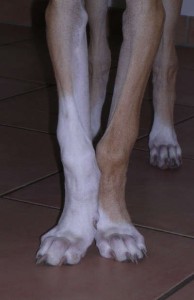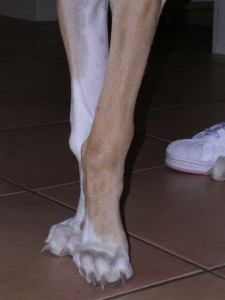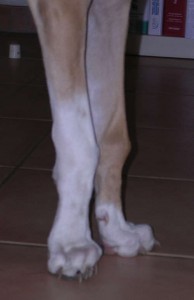Nutrition
On the Nutrition of the Azawakh – How to Prevent Growth-Related and Other Problems
The Azawakh has a couple of specifics both from the anatomical and functional point of view, which have evolved during the course of the development of the breed as a result of conditions in which the breed lived. Although the Azawakh has been bred outside its homeland for almost forty years now, the breed has preserved such specifics until the present, and it is necessary to take these into consideration.
For centuries, the Azawakh breed has lived on a low-protein diet in its region of origin. In Africa, the diet of the Azawakh is composed almost of the same food as that one of their owners, based on millet and goat milk, and the digestive system of the breed has been therefore adapted to such conditions. During the whole life of the dog, the organism of almost all the Azawakhs produces an enzyme capable of digesting lactose (milk sugar). In the majority of other dog breeds, such a capability exists only in the early months of the dog’s life when puppies feed on their mother’s milk.
This is the reason why the majority of the Azawakhs may ingest milk throughout their whole lives without suffering from diarrhoea or other types of indigestion. In the breed’s regions of origin, the protein content in the Azawakh diet is generally lower as compared to an average dog diet, as the Azawakh lives just on cooked millet, some dairy products and only minimum of meet. The Azawakh is genetically adapted to such conditions, which is why even here in Europe, these dogs should not be overfed with a dry food of a high content of protein or large quantities of meat, as such a diet could lead towards serious health problems, such as growth-related problems in the early months of the dog’s life (incorrect frontstand). When the protein ingestion is excessive, dogs tend to grow too fast, which may result in a damage of ligaments, especially if the dog also suffers from overweight. An Azawakh puppy should be slim (however also not too thin or even undernourished).
If a puppy is fed with industrial dog food, it should be fed with a junior food with a lower contents of protein (which means 25 % of protein content as a minimum, however not over 30%), served soaked with a mixture of lukewarm water and milk or dairy products, such as cottage cheese, yoghurt and sour milk. Lower protein content by no means implies a lower quality of food! Fermented dairy products are generally easier to digest as compared to milk as such, especially cow milk, in which the content of fat is rather high. On the other hand, if the protein content in the dog food were much lower, nutrition anaemia may appear with all typical symptoms of such an illness.
It is possible to add fruits and vegetables in the dog’s diet, such as bananas, carrots, etc., and sometimes cooked millet or pasta or wild rice may be added and a little bit of raw (or if it makes you more comfortable, cooked) meet, such as chicken or beef or raw tripe, which also supports digestion. In the case of feeding raw meat, for hygienic reasons it is more convenient to use deeply frozen meat, served after being de-frosted. In the majority of the cases, puppies are fed three times a day until they are 5-6 months old, and afterwards twice a day throughout their whole life. It is adequate to break down the feeding dose of an adult dog not just in order to support digestion, but it is also a step towards a prevention of the bloat (gastric torsion). This is a life-threatening medical condition, which is treated with an immediate surgical intervention. Mortality rates in dogs range from 10 to 60 percent, even with treatment. With surgery, the mortality rate is 15 to 33 percent. Deep-chested breeds are especially at risk, such as Great Danes, Irish Wolfhounds, German Shepherds, Rhodesian Ridgebacks, etc., and although it occurs rather rarely in the Azawakh, the risk of the occurrence of such a condition cannot be underestimated. For such a reason, exercising immediately before or after a meal (after feeding, no wild playing, jumping, etc. during 1-2 hours.) should be avoided in adult dogs.
The Azawakh is genetically “equipped” for such a type of feeding already from its regions of origin, and we should try to continue feeding a similar diet in order to prevent health problems. The pictures below illustrate a medical condition of an Azawakh puppy, fed as mentioned above by the breeder and given to the new owner in good health condition. The new owner, however, wishing the best for his new puppy, changed the diet and fed the puppy with lots of raw meat, as he considered such a diet proper and more natural for a carnivorous animal. This puppy suffered a sudden “protein shock” and developed growth-related problems in front legs only three weeks after being taken by the new owner. This was an initial state of the Radius Curvus syndrome, which means that the growth of the ulna stops while the radius continues growing. Due to such a condition, the radius bends and the forearm is arched and paws are turned outwards, and pain in elbows occurs. Of course, such an extreme reaction to improper nutrition does no appear in each puppy, however such a possibility does exists. Due to the fact that in the Azawakh, there is a genetic disposition towards such a condition and it has been appearing in some bloodlines recently, however, it has not been studied and “mapped” in the breed, besides a careful selection of breeding stock, the owners should not contribute to such a risk feeding an improper diet.



On the basis of data provided by MVDr. Gabriele Meissen, processed and complemented by Jana Vrbacká




